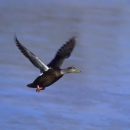Seasons of Wildlife
Endangered Species
The U.S Fish & Wildlife Service leads the Federal effort to protect and restore animals and plants that are in danger of extinction, both in the United States and worldwide. Using the best scientific evidence available, Service biologists identify species that appear to be endangered or threatened. After review, species may be placed on the Interior Department’s official “List of Endangered and Threatened Wildlife and Plants.” Service biologists, along with other partners, then develop recovery plans for the species that include research, habitat preservation and management, and other recovery activities.
Canada lynx —Threatened
Canada lynx are a large tawny colored cat characterized by their ear tufts, long hind legs and large snowshoe-like feet. They have been confirmed breeding in northeastern Vermont. Lynx occur in boreal forest habitats that support their principal prey, snowshoe hare, such as those found in the refuge’s Nulhegan, Pondicherry, and Blueberry Swamp Divisions.
Dwarf wedgemussel – Endangered
This freshwater mussel is an inhabitant of muddy sand, and sand or gravel bottoms of rivers and streams. This mussel once occurred along much of the Connecticut River and many of its tributaries, but is no longer found in the mainstem in Connecticut and Massachusetts. The species was rediscovered in the upper Connecticut River in 1995, including 68 sites in the mainstem and 77 sites in tributaries.
Puritan tiger beetle – Threatened
The Puritan tiger beetle is an inhabitant of sandy riverine beaches along the Connecticut River and sandy bluffs along Chesapeake Bay in Maryland. The Puritan tiger beetle has declined along the Connecticut River due to flooding and disturbance of its shoreline habitat from dam construction, riverbank stabilization, and human recreational activities. Of 11 known historic populations along the Connecticut River, only two remain.
Northeastern bulrush – Endangered
The Northeastern bulrush is a leafy, tufted, perennial sedge that ranges from Maryland and Virginia to New England. It is found growing on the edges of seasonal pools, wet depressions, beaver ponds, and wetlands that have variable water levels. Habitat loss and pollution were key factors in the decline of this bulrush. There are only thirty two known populations of this bulrush found within the Connecticut River watershed.
Shortnose sturgeon- Endangered
The shortnose sturgeon is a primitive looking fish with five rows of bony plates covering their body and a mouth located on the underside of their head. The Connecticut River shortnose sturgeon were thought to be extirpated until an isolated population was located between the Turners Falls Dam and Holyoke Dam in Massachusetts. Individuals are found below the Holyoke Dam, but they are isolated from upstream breeding habitat. The primary impediment to sturgeon recovery is the presence of dams that obstruct migration and modify the historic river flows that cued the fish to spawning at appropriate times and places.
Host to a variety of wildlife species
Birds
The Connecticut River watershed serves as one of the major migration corridors within the expansive Atlantic Flyway, and provides nesting habitat for many priority forest birds including wood thrush, Canada warbler and Bicknell’s thrush, grassland and shrubland birds like the grasshopper sparrow and American woodcock, and globally significant populations of nesting saltmarsh sparrow, as well as wintering habitat for thousands of American black ducks. As watershed habitats become lost to development, the protected lands within the Silvio O. Conte National Fish & Wildlife Refuge become critical to wildlife, especially migrating and breeding birds. Development within the watershed is fragmenting large forest blocks, and tends to occur along the Connecticut River mainstem, where important habitats, such as floodplain forests, are lost.
Fish
There are 142 fish species found within the watershed. The northern reaches of the river provide habitat for lake and Eastern brook trout and land-locked Atlantic salmon. The mid-section of the river supports chain pickerel, largemouth and smallmouth bass, Northern and walleyed pike, and panfish such as bluegill, as well as, summer flounder, and striped bass are found at the mouth of the river. Common carp, suckers, American eel, channel catfish, and brown bullhead are present in many areas.
Featured Species
The Silvio O. Conte National Fish and Wildlife Refuge was established to protect the diversity of native species of plants, fish, and wildlife and their ecosystems within the Connecticut River watershed. The natural environment of the 7.2 million acre watershed is extremely diverse and expansive. Refuge divisions and units were established to protect some of the most biologically significant areas within the watershed. Refuge lands are managed to support wildlife and habitats of conservation concern, such as federal listed species, migratory birds and fish, and wetlands. Refuge lands also provide connectivity to other open spaces essential for the movement and adaptation of plants and animals.





